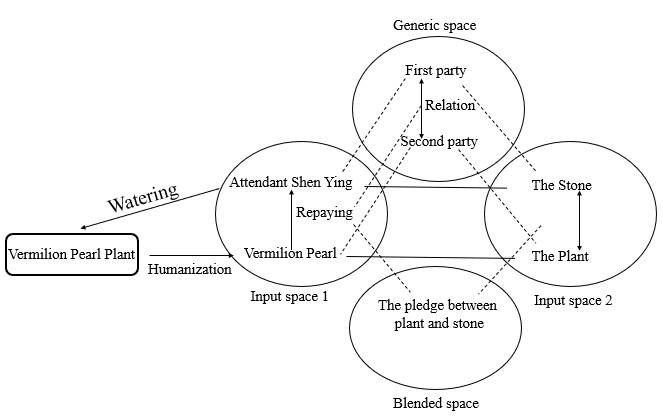A Metaphor Analysis of Love Allusions in A Dream of Red Mansions
Abstract
The paper explores two love allusions, ‘the pledge between plant and stone’ and ‘Jin’s marriage’ in the Chinese literary classics A Dream of Red Mansions written by Cao Xueqin and provides new explanations to the theme of the novel. Nearly 20 metaphorical expressions in the novel are selected through Critical Metaphor Analysis with 6 specifically representational examples analyzed in the paper by building integration networks based on Conceptual Integration Theory (CIT). The findings are as follow: 1) the counterculture of ‘plant and stone’ is embodied in the mythological stories at the beginning of the novel. 2) a ‘nested integrational network’, originally proposed by the researchers, links the mythological narrative space and the fictional human world space. 3) the comparison between integration networks of the two love allusions shows anti-feudalism of the author Cao Xueqin. This paper offers an interpretation of the novel from the aspect of cognitive linguistics, which, in turn, could promote the development of CIT within this field.
Downloads
References
Cao, Xueqin, & Gao, E. (1994). A Dream of Red Mansions. Trans. Yang Xianyi., and Gladys Yang. Beijing: Foreign Languages Press.
Cao, Xueqin, & Gao, E. (2016). A Dream of Red Mansions. Beijing: Commercial Press.
Charteris-Black. (2004). Corpus Approaches to Critical Metaphor Analysis, Basingstoke: Palgrave Macmillan.
Chen, Hong. (2016). Hong Loumeng ‘mushi’ kaolun (Research on ‘plant and stone’ in A Dream of Red Mansions). Wenxue yu Wenhua (Journal of Literature and Culture), (3): 24-35. http://doi.org/ 10.13896/j.cnki.wxywh.2016.03.004
Cheng, Yige, Peng, Chen, & Huang, Qun (2017). Gainianzhenghe shijiao xia Hong Loumeng zhong mingzi de yuyin yinyu (Phonetic metaphor in A Dream of Red Mansions through conceptual integration). Haiwai Yingyu (Journal of Overseas English), (3): 197-198
Coulson, S., & Oakley, T. (2005). Blending and coded meaning: Literal and figurative meaning in cognitive semantics. Journal of Pragmatics, 37(10), 1510-1536. https://doi.org/10.1016/j.pragma.2004.09.010
Fauconnier, G. (1997). Mappings in Thought and Language. London: Cambridge University Press. https://doi.org/10.1017/CBO9781139174220
Grady, J. (2005). Primary metaphors as inputs to conceptual integration. Journal of Pragmatics 37.10:0-1614. https://doi.org/10.1016/j.pragma.2004.03.012
Grady, J., & Mark Turner. (2002). The Way We Think. New York: Basic Books.
Huang, Chonghao. (2001). Liangxing chongbai yu mushi qianmeng (Worship of both sexes and ‘the pledge between plant and stone’). Huang Gang Shifan Xueyuan Xuebao (Journal of Huang Gang Normal University), (6), 20-23
Lakoff, G., & Mark J. (2003) Metaphors we live by. London: The university of Chicago Press. https://doi.org/10.7208/chicago/9780226470993.001.0001
Lan, chun. (2013). Cong Renzhi Shijiao Kan Fojing Baojijing Zhong de Biyu (A Cognitive Perspective on the metaphors in the Treasure Machine Sutra). Zhongguo Waiyu (Foreign Language China), 9(4), 25-33. http://doi.org/10.13564/j.cnki.issn.1672-9382.2012.04.019
Li, Ye. (2006). Hong Loumeng ‘mushi qianmeng’ yuanxing de wenhua kaozheng (Cultural research on ‘the pledge between plant and stone’ in A Dream of Red Mansions). Liao Cheng Daxue Xuebao: Shehui Kexue Ban (Journal of Liao Cheng University: Social Science Edition), (6), 80-81. https://doi.org/10.16284/j.cnki.cn37-1401/c.2006.06.020
Meiners, S., Pickett, S., & Cadenasso, M. (2015). Conceptual frameworks and integration: Drivers and theory. In An Integrative Approach to Successional Dynamics: Tempo and Mode of Vegetation Change (pp. 48-64). Cambridge: Cambridge University Press. https://doi.org/10.1017/CBO9780511844218.005
Oakley, T., & Pascual, E. (2017). Conceptual Blending Theory. In B. Dancygier (Ed.), The Cambridge Handbook of Cognitive Linguistics (Cambridge Handbooks in Language and Linguistics, pp. 423-448). Cambridge: Cambridge University Press. https://doi.org/10.1017/9781316339732.027
Sun, Yi. (2019). Dangdai Yinyuxue de Lilun Fanshi Gounian (The theoretical paradigm of contempory metaphor research). Hainan Daxue Xuebao Renwen Shehui Kexue Ban (Journal of Hainan University Humanities and Social Sciences), 37(6), 126-134.
Tang, Yingling. (2018). On the Semantic Mapping Mechanism between the Jingling Registers in A Dream of Red Mansions and Related Characters from the Perspective of Conceptual Blending Theory. Diss. Sichuan Normal University.
Xu, Jie. (2012). A Study On Metaphor Translation In Hong Lou Meng From the Perspective of Conceptual Blending Theory Diss. Shanghai International Studies University.
Xu, Zhongrong. (2018). Hong Loumeng zhong ‘mushi’ yixiang de wenben yiyi bulun (Supplementary discussion about the textual meaning of ‘plant and stone’ in A Dream of Red Mansions). Tian Zhong Xuekan (Journal of Tian Zhong), 33(2), 107-112. http://doi.org/ 10.14058/j.cnki.tzxk.2018.02.019
Yang, Jiayou, & Yang, Jianhong (2010). ‘Jinyu liangyuan’ yu ‘mushi qianmeng’ de sixiang jiedu (Research on ‘Jin’s marriage’ and ‘the pledge between plant and stone’). Lan Zhou Xuekan (Journal of Lanzhou), (8), 160-162. https://doi.org/10.4028/www.scientific.net/AMR.160-162.1257
Yu, Shulin. (2010). Application of Conversational Implicature Theory to The Analysis of The Utterances in A Dream of Red Mansions—Case Studies of The Maids’ Utterances Diss. University of Electronic Science and Technology of China.
Zheng, Chenyin (2000). Cong mushi chongbai kan Hong Loumeng zhi ‘mushi qiyuan’ (‘The pledge between plant and stone’ in A Dream of Red Mansions judging from worship of plant and stone). Hong Loumeng Xuekan (Journal of A Dream of Red Mansions), 03, 104-113.
Zhou, Ruchang. (2013). Honglou duomu hong (Red buildings dazzling red). Bei Jing: Writer Press.


This work is licensed under a Creative Commons Attribution 4.0 International License.
Copyright for this article is retained by the author(s), with first publication rights granted to the journal.
This is an open-access article distributed under the terms and conditions of the Creative Commons Attribution license (http://creativecommons.org/licenses/by/4.0/).









1.png)









1.png)











